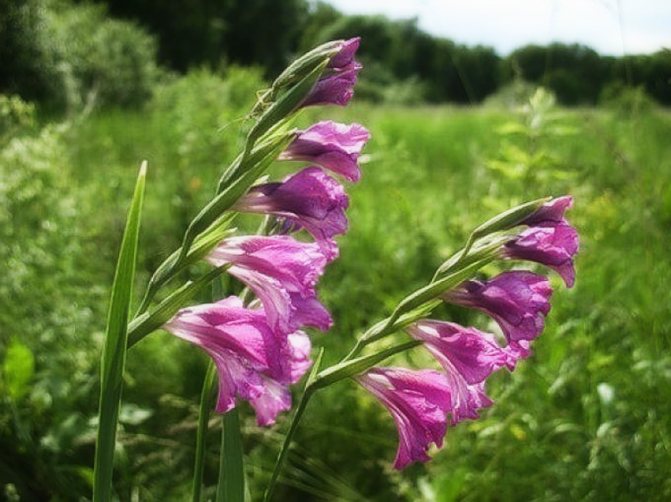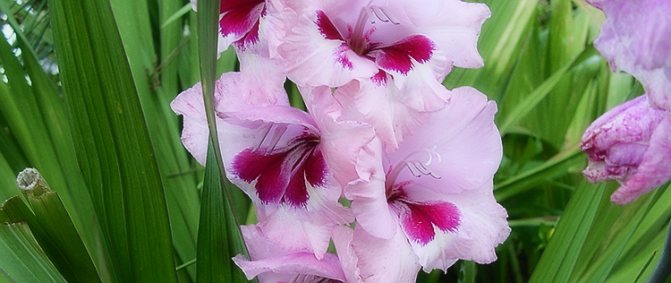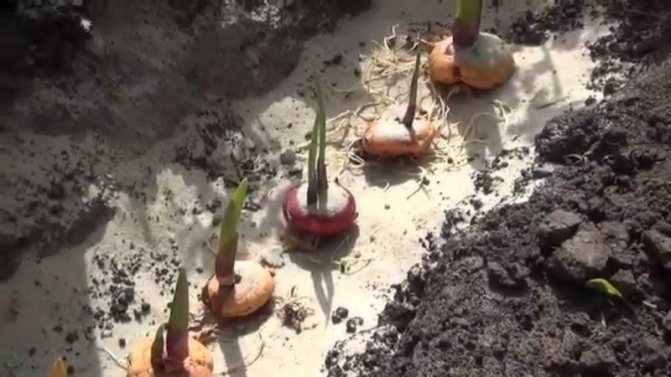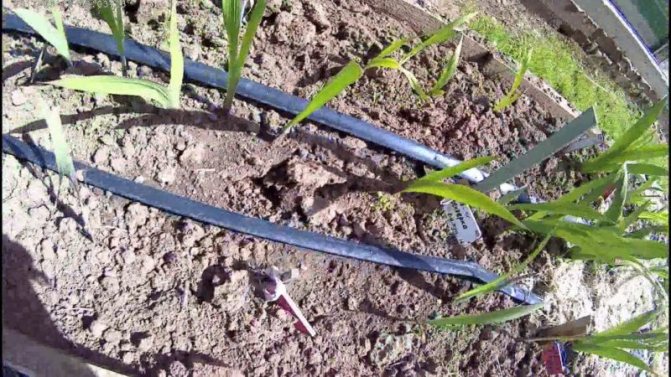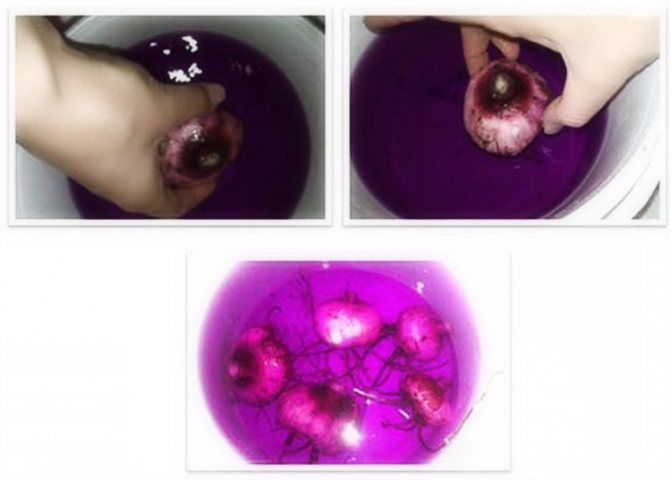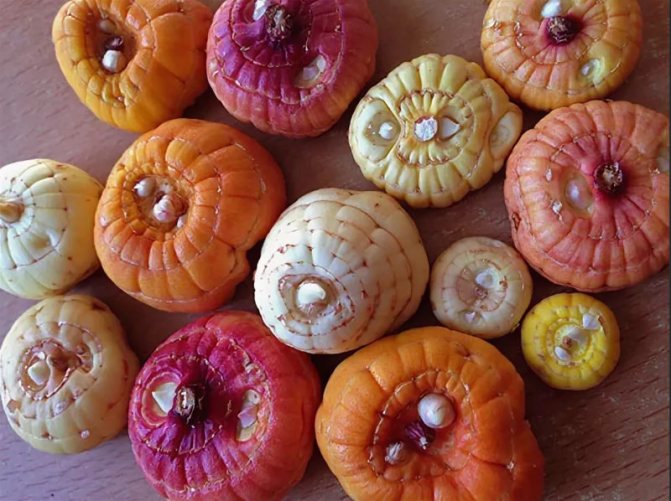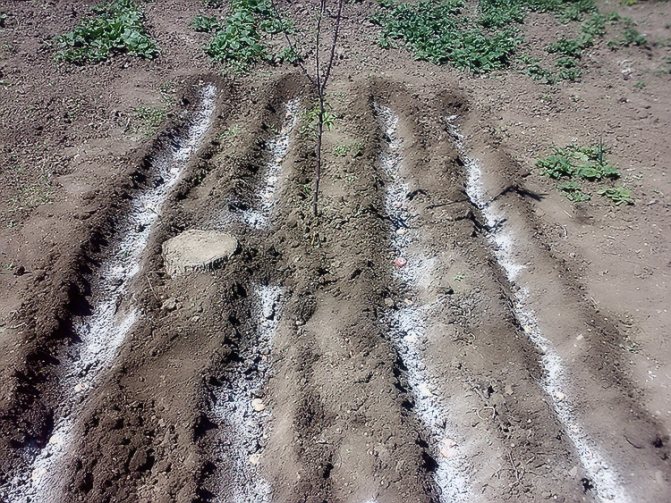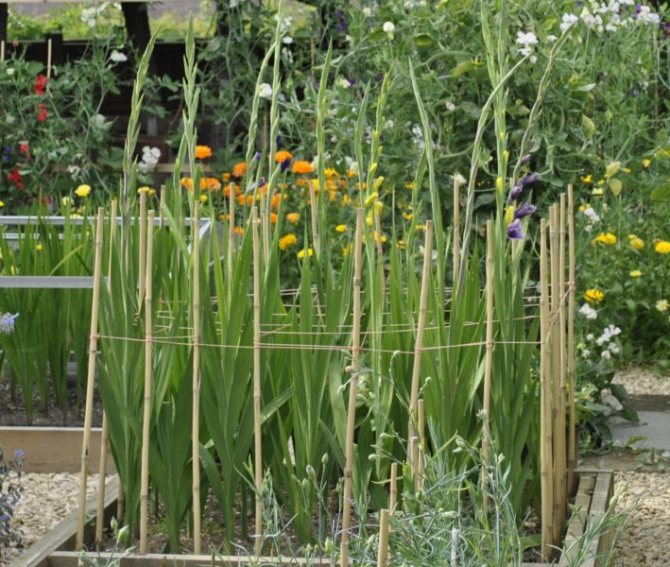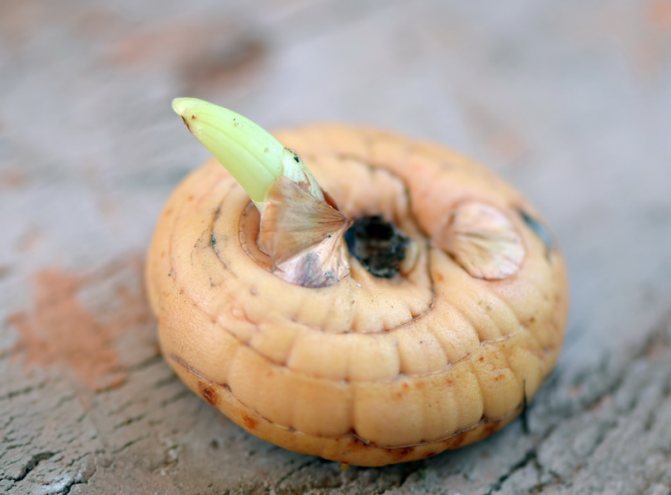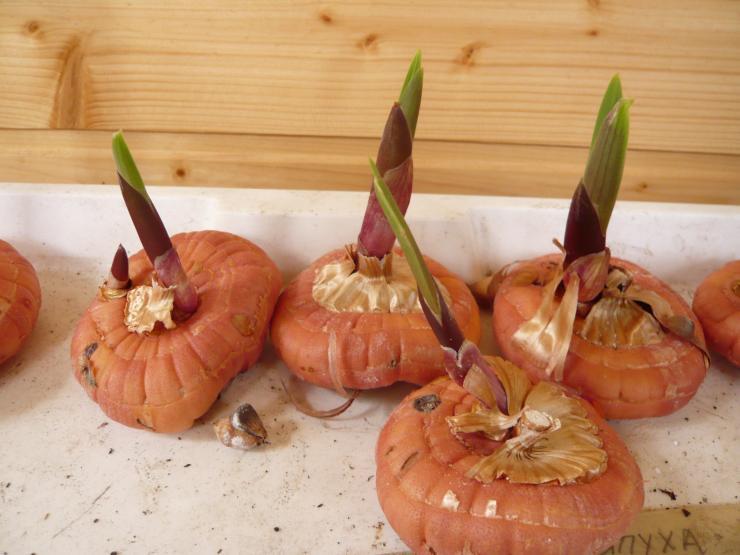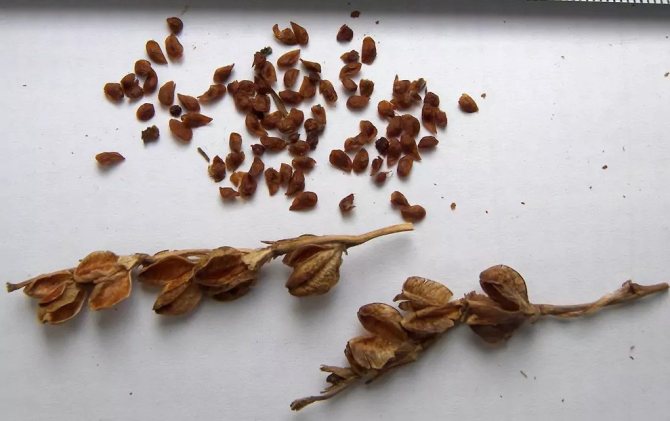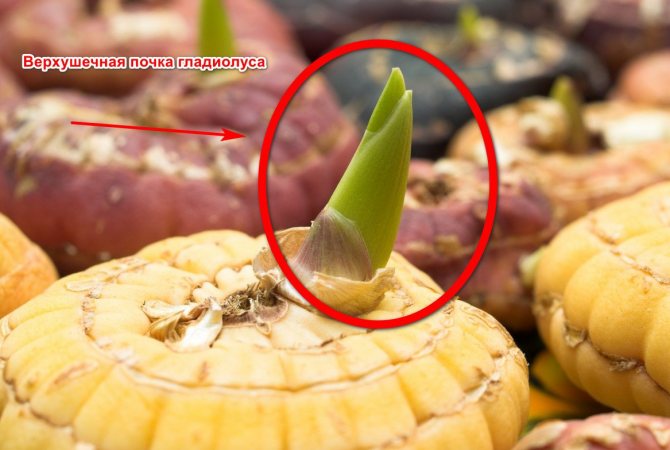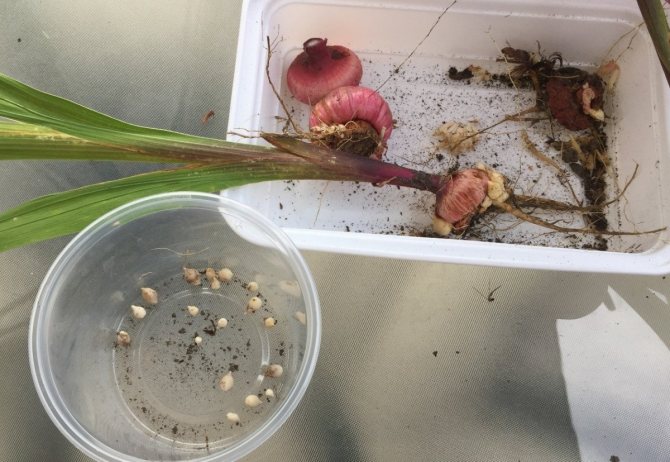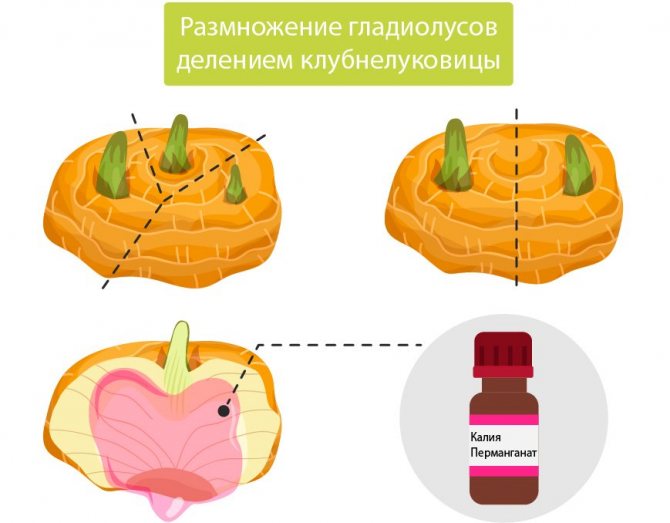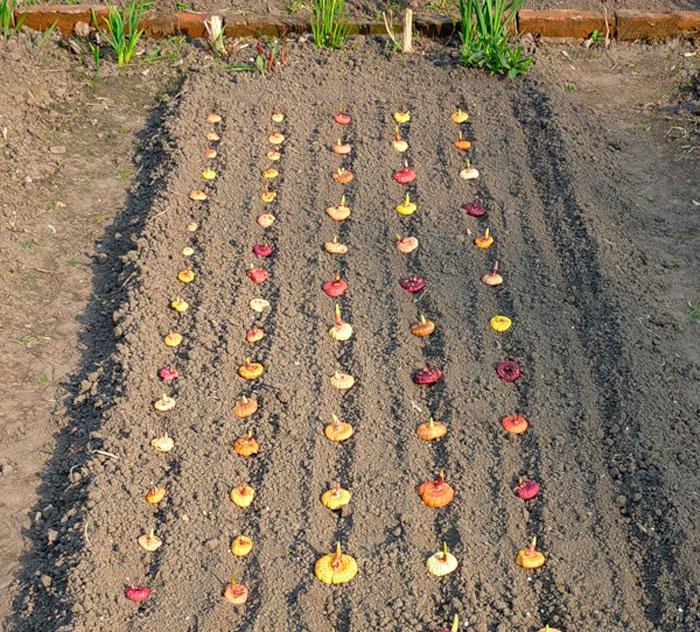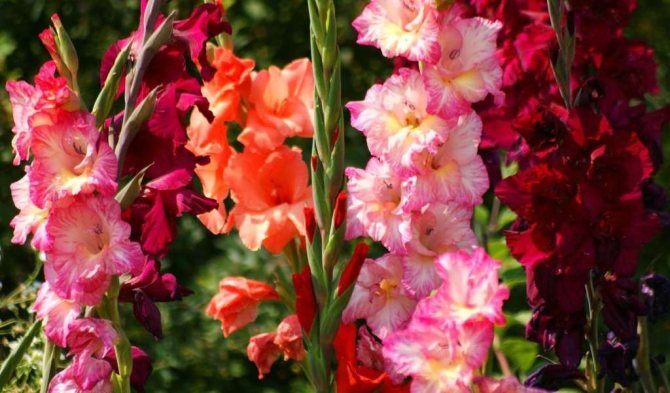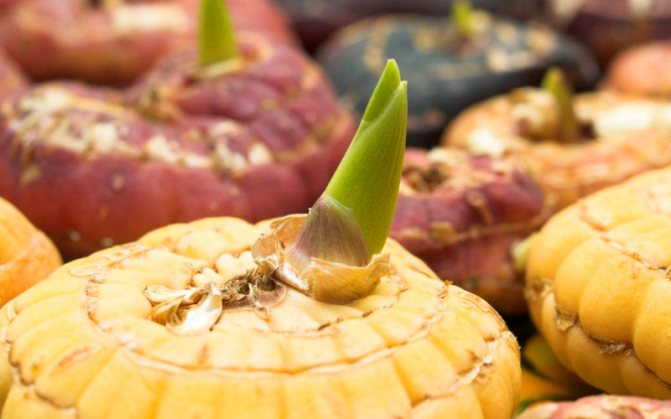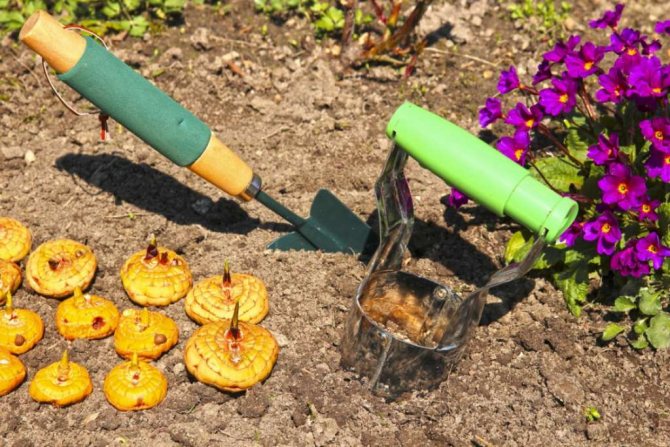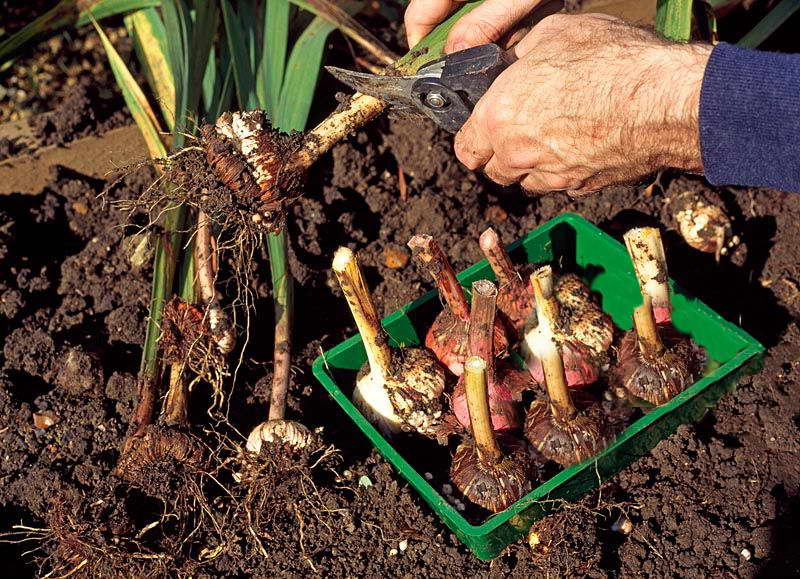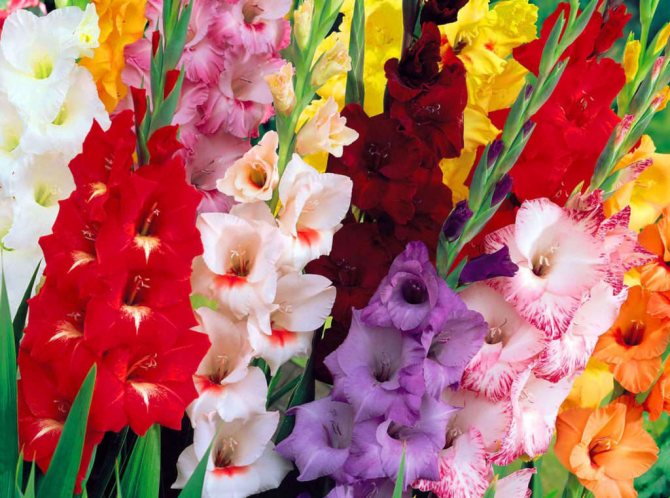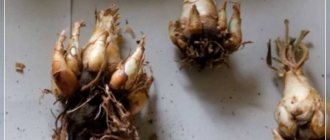In our family, gladioli have a special attitude. Probably because these are my mother's favorite flowers. Now imagine my joy when I have a "small piece of land"! Guess what was the first on the list of crops that I want to grow on the site? Favorite greens: dill, parsley? Tomatoes, without which it is difficult for me to imagine a menu for my family? Peanuts that are not only delicious, but also look beautiful in the garden when they bloom? Of course not! Mom's favorite gladioli!
And so I bought the onions. I listened to the seller's detailed instructions. I dropped it off by all the rules. They grew up amazingly beautiful ... and that's it! Unfortunately, there is no continuation. I did not find any onions in the ground so that I could dig them up and send them to the balcony for the winter. They did not germinate the next year. And believe me, I don’t feel sorry for the pennies that I paid for the seed. Do not mind the effort, because in the first year they were completely justified. It saddens me that I did not know everything about planting and caring for a plant in order to prolong their life and flowering. Therefore, our conversation today and gladioli. And about everything related to their cultivation!
Planting and caring for gladioli outdoors
The first thing to understand is that, despite all the inventions of breeders who have come up with varieties that grow both on the mountains and under water (I exaggerate), it is worth considering the natural conditions for the growth of gladioli (skewers). Only then will we understand what the plant needs to make it feel comfortable, and, accordingly, the bush would be healthier, and we would observe more lush and prolonged flowering, and pests so as not to bother either the root system or the aboveground one.
The tropics and subtropics are the homeland of the skewers. And accordingly, the plant expects us to plant it in "light" soil, where most of it is organic. It would be ideal to mulch the plantings with straw, deciduous humus. In this case, watering is desirable small, but frequent. Best of all, sprinkling in the morning or evening. It is allowed to have a shade in the flowerbed where the gladiolus will grow. But at the same time, the land should not be clogged with roots. This means that the neighbors must be minimized as much as possible. It is best to give the garden bed completely at the disposal of this culture, and plant other herbs and flowers along the edging.

Now we know approximately where and what kind of flowerbed. Consider the peculiarity of this plant:
- sunny bed with little shading;
- moderate timely watering;
- obligatory plant feeding;
- a protected place from drafts so that the peduncles are not bent to the ground;
- the soil in the flowerbed must contain a lot of organic matter.
What is important to consider when planting for successful plant growth:
- Wait until the soil warms up to 10 degrees. But you need to measure the temperature not on the surface, but at a depth of 10 cm (or planting depth). And this is approximately from mid-April (in the southern regions) to mid-May (in a more severe climate).
- By the way, all bulbs are planted at a depth that is 3 times greater than the bulb itself (if the soil is dense; in looser soils, the planting depth is 4 times greater).And therefore, it will not be possible to dig the same trench for all plants if one bulb is 2 cm, and the second is 3-4!
- The appearance of the flower bed will depend on the landing scheme. For example, 20 by 20cm is a tight fit. 20 to 30 is looser, but it is optimal for lush bushes.
Advice! Do not plant strong adult crops (you can tell by bulb size and age) next to juveniles. Then the strong plants will overwhelm the weaker ones. It is best to sort the tubers and plant them according to their size.
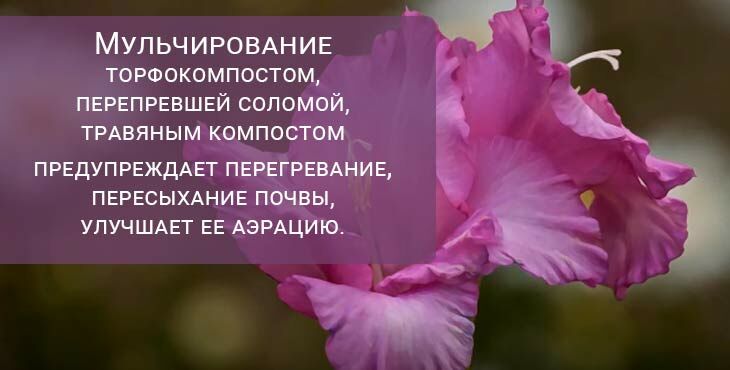

What is important in the care of gladioli:
- Watering. As it grows - 2 times a week, an adult plant - 1 time per week (20 liters per 1 sq.m.). Watering under the bush.
- Loosening. They say that one loosening replaces 2 waterings. And for sure! For the benefits it brings to the plant, loosening the soil is incredibly important for gladioli.
- Top dressing. When seedlings appear, nitrogen-containing fertilizers are applied to the soil. When 5-6 leaves appear, phosphorus is added to nitrogen. Buds appear - phosphorus and potassium.
- Protection from pests. The tubers themselves are processed, but it is also worth spraying the bushes with special agents (insecticides) that protect them from the whitefly.
- Garter... It is necessary for rare / single plantings, with winds or when the soil does not support the plant.
There are no special difficulties or problems with growing these flowers, as you can see. Skewer is considered an unpretentious crop. And therefore, you will definitely succeed in growing it!
Description and varieties of gladioli
Gladiolus is one of the tallest garden flowers, its stem can be up to 170 cm long. The leaves are attached closer to the root and directed upward to the inflorescence. The plates are elongated. An inflorescence is an ear consisting of a group of flowers that can be of a simple, semi-double or double shape.
Consider the popular varieties of gladioli:
- Annushka variety - reaches a height of more than one and a half meters. It has delicate flowers with corrugated yellow-orange petals. The size of the inflorescences is 12-16 cm.
- Arina is represented by corrugated pink flowers. It features a bright crimson spot in the middle of the flower.
- Variety Eternal Call - the stem grows up to 135 cm. Flowers have an orange-red edging around the white center.
- Blue butterfly - the variety is distinguished by light white-blue petals. The stems grow in length from 120 to 140 cm. The culture can bloom 2 months after planting.
- The Sky and Stars variety is rather unpretentious. Differs in large blue-violet corrugated flowers. Each petal has white rays.
- The Snegurochka variety stands out with corrugated white inflorescences. It begins to bloom approximately 85 days after planting.
- Spartacus - plant height reaches 165 cm. Flowers have a brown-red tint with a smoky tint. There is a white spot on the bottom of the flower.
- The golden ten is a flower with bright yellow large double petals.
- Moscow Belokamennaya - stems reach one and a half meters in height. The flowers have snow-white petals. The number of buds reaches 21. Flowering begins in July.
- Priscilla - the flower has a white-pink hue and a crimson border. The stem height reaches 1 m.
- Amber Baltica - has a stem 150 cm high. It has an apricot shade of petals. On the peduncle there are up to 23 buds, which form large flowers.
- White birch - the variety has a long ear with corrugated white flowers. 24 buds are laid.
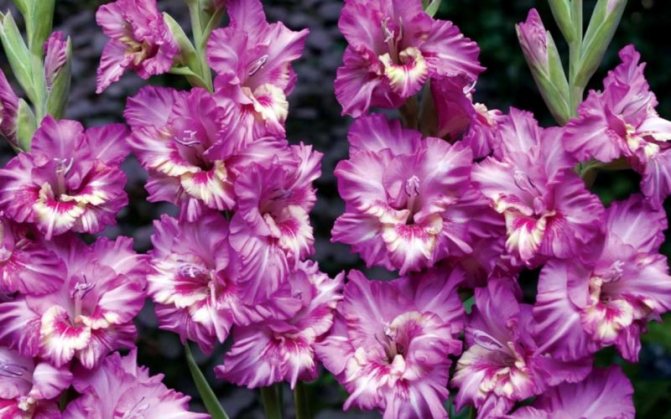

Gladioli
How to prepare gladioli for planting after winter storage
If you are preparing for planting, the first thing you need for gladioli is to get them (from the basement or from the balcony) 2-3 weeks before planting the plants in the soil.
How to prepare planting material and what you should pay attention to:
- Inspection. The initial examination is to make sure that the bulbs are healthy and free of any defects, damage or disease.If there are defects (damage), cut off part of the bulb (after soaking) and process the cut with charcoal or brilliant green.


- Cleansing bulbs from the husk.


- Sorting. If the bulb has a small bottom, then it is young and strong, and will give good shoots. The big bottom is old bulbs and should be replaced.
- Etching. We breed 1 gr. potassium permanganate per 10 liters. water (you can make the solution slightly weaker if roots have appeared and the onions have sprouted). And soak for 2-3 hours.
- Soak in biostimulants for better root formation.


- Germination (optional). After soaking, spread the bulbs on the moistened sawdust.
Now it remains to wait for the bulbs to germinate and the soil warms up.
Diseases
Gladioli are susceptible to the same diseases as all bulbous plants. And also the danger is represented by fungi and all sorts of pests (mites, aphids, caterpillars). Most varieties are the result of selection, the main criterion of which is appearance. Therefore, many species have practically no immunity of their own and can die without human intervention.
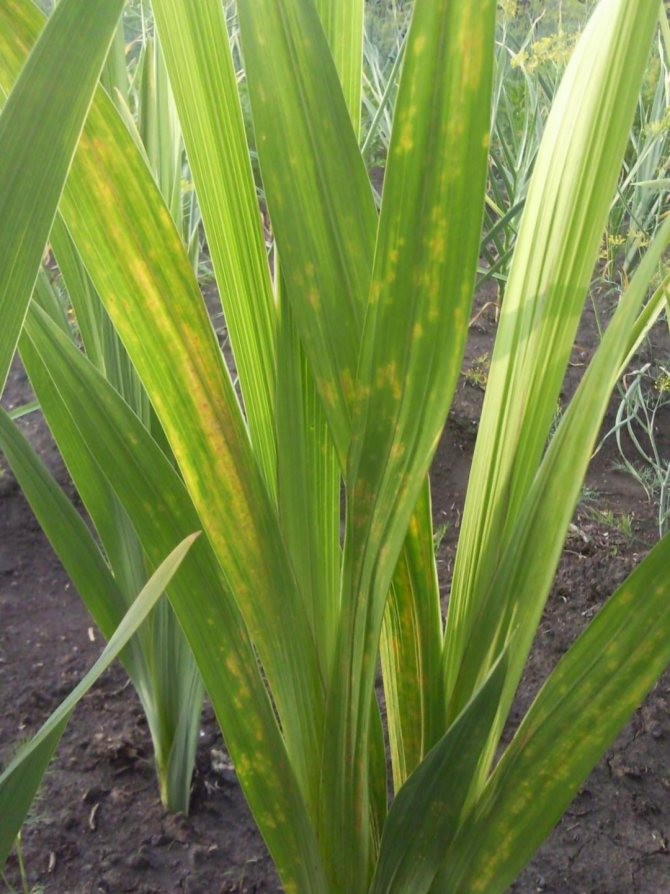

Gladioli are susceptible to many diseases and are attractive to pests
Fusarium
The causative agent of the disease is a fungus that infects the bulb, penetrating into it through the soil. This usually happens with excess moisture.
The disease prevents the growth and development of the aerial part of the plant. This causes the leaves to turn yellow. The bulb itself is covered with brown spots. Bordeaux liquid is used for treatment.
Sclerotiniasis (dry black rot)
Another fungal disease that occurs in excessively acidic moist soil or with an excess of humus. The risk of development increases when grown in the shade.
The fungus infects the bulbs, as a result of which it gradually dries out and dies. At the same time, the leaves become brown, dry out and fall off. If untreated, the plant dies. You can destroy the fungus with Bordeaux liquid. All infected bulbs will have to be burned.
Botrythiasis (dry gray rot)
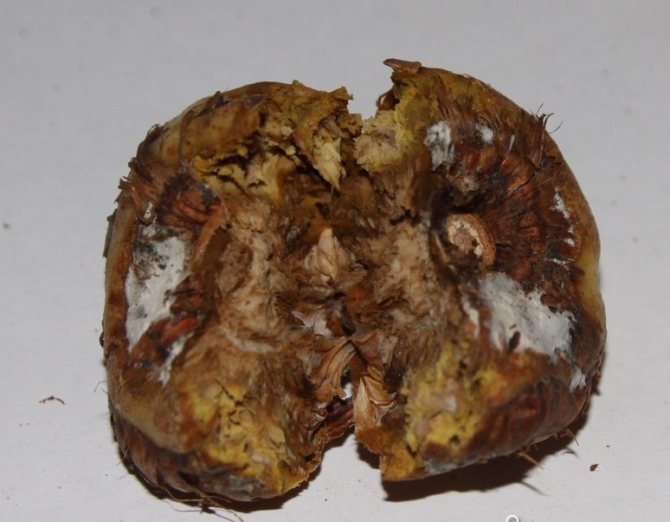

Botrythiosis affects the bulbs, and then the whole plant dies.
Fungal disease occurs with a constant excess of moisture in the soil and a lack of heat. The bulbs of the plant are covered with brown watery formations, and the aerial part of the gladiolus dries up. Then the whole plant starts to rot and dies. For treatment, copper sulfate, Bordeaux liquid or Fundazol are used.
Scab
A bacterial disease that occurs when there is an excess of moisture in the soil. This may be due to high groundwater levels, frequent irrigation or heavy rainfall, excessively clayey soil that retains moisture.
Red or brown spots appear on the leaves and stems, which gradually increase in size and turn into sores. The plant is rotting, so it needs to be treated. First, you can cut off the damaged parts and treat the stems with ash or crushed coal. But the main thing is to reduce the moisture content of the soil around the flowers. Bacteria are always present in the ground, but they are activated precisely when conditions are favorable for them.
Hard rot
A fungal disease characterized by black spots or dots on the leaves and stems. The affected areas increase in size and harden. The reason is the increased humidity of the soil and air as a result of damp weather. It is extremely difficult to cure the disease. It is recommended to destroy all infected plants.
Root mite
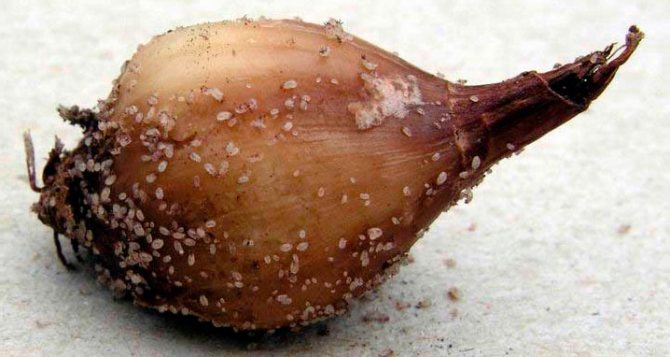

Root mite affects bulbous flowers, not only gladioli
These are small parasites that live on all bulbous plants, feeding on corms. In appearance, these are small translucent insects living in entire colonies. They can be seen with the naked eye if the tuber is dug up. They prefer humid and hot weather.
The main symptom is yellowing of the leaves and drying out of the plant for no apparent reason. To get rid of the parasite, it is necessary to treat the soil with karbofos or insecticides. Infected bulbs must be burned.
Thrips
It is a pest insect. In appearance, they look like a small black earwig, since their body is elongated. Pests affect the bulbs during storage, when the room temperature is above + 10 ° C.
The bugs settle under the scales and feed on the bulbs. After planting, the laid-off larvae move from tubers to leaves and stems. To get rid of parasites, insecticides are used.
We germinate gladioli before planting
We place the tray with cunning sawdust in a warm place, protected from direct sunlight. If necessary, spray the sawdust from a spray bottle. We check if any onion has 2 or more processes, the onion can be carefully divided into parts by treating the "seam" with ash.


We regularly inspect the material, checking if the bulbs and sprouts are healthy. With the appearance of 3 cm sprouts, the bulbs can be planted in the soil.
If you want to get gladioli by September 1, then you do not need to germinate.
How to store gladioli
After digging out, the corms are placed in a well-heated room, at a room temperature of + 22 ... + 25 ° C. They must be turned over daily so that no damage appears. The bulbs should be dried for no more than 3 weeks, during which time the scales dry up and acquire a glossy sheen. After this period, the tubers are moved to a cooler place. In an apartment, this can be the floor space next to the balcony door, and in a cottage, it can be a basement or cellar.


It is best to store in cardboard or plastic containers with air holes. Corms can be placed in several layers, laying them with newspapers or loose paper. The best temperature will be + 3 ... + 10 ° С, air humidity not less than 70%. Bulbs should be checked regularly and any diseased or dried bulbs should be disposed of.
It is worth remembering that at the end of winter, gladioli begin a period of active growth, which must be slowed down. To do this, you can put mint leaves, green apples in the container.
We plant gladioli bulbs in spring
When both the soil and the material are ready for planting, we plant the sorted bulbs in the flower beds.
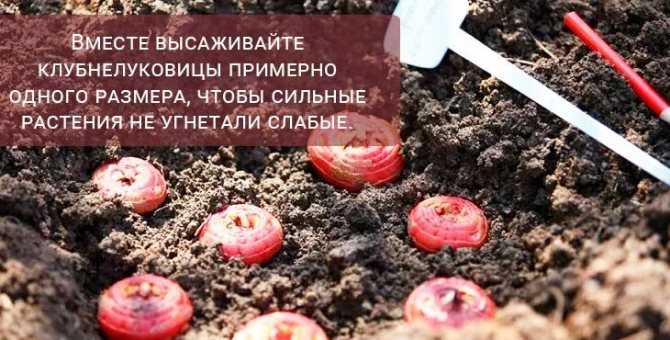

How to do it right:
- Water the soil to anchor the bulb in the soil.
- If you haven't fertilized since autumn, add plant compost and mineral fertilizers.
- If the ground is loose and light, plant coarse planting material to a depth of 4 diameters - roughly speaking, a shovel bayonet. In loams, the depth can be reduced to 3 diameters, but not less. The same rule works with tubers.
- Lower the onion, cover the onion with 1.5 cm of sand. The second option - sprinkle the bottom of the hole with a layer of sand (1–1.5 cm), lower the tuber and sprinkle it with 1.5 cm of earth.
- Water a little again.
- And only after that cover with earth.
Distance between bulbs from 20cm. the distance between the rows is 30-40cm.
When to dig up and how to store bulbs in winter
To dig up the bulbs and store them until next year, you need to make sure they are ripe. Therefore, take into account the timing: the bulbs are dug up in September-October, in warm, dry weather. At least a month is required for the bulb, free from the peduncle, to accumulate the necessary juices in order to safely endure the winter. But it is better to give even more time, up to 45 days.
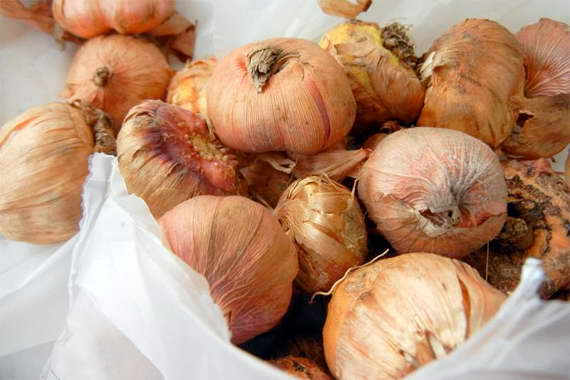

When digging up gladioli, remember that they give babies, and try not to damage them. The sides of the old corms can be literally covered with little "babies", which, of course, we want to grow and plant in the spring.
- First, the bulbs are dug up only in dry weather. They start with early varieties of corms. When cutting off the stem, it is necessary to leave the stem 2-3 cm long from the beginning of the bulb.
- After shaking off the ground and pruning the roots, it is necessary to carefully examine the bulbs to exclude those specimens that may be carriers of diseases.
- The bulbs of each variety are individually washed under running water, dried and subsequently treated twice with an antifungal solution of foundationol.
- Further drying is carried out in the sun, in a well-ventilated place for a month.
After drying, each onion is separated from each other (this applies to the old, new replacement and "babies"), wrapped in paper for storage and the variety is signed.
- All bulbs are folded into a cardboard box and stored closed to retain maximum moisture during wintering.
- You can store them on the bottom shelf of the refrigerator. Small "children", up to 1.5 cm in diameter, are kept in paper bags under the same conditions as their parents.
- During the rest period, and this is the first 1.5-2 months, there should be no problems with the bulbs at all. After this time, they begin to look after the gladioli bulbs in order to avoid early germination and to exclude the occurrence of diseases.
- Garlic cloves, which act as a natural air decontaminant, are added to the onion containers and placed in a well-ventilated, cool place.
Care and planting of gladioli must be correct. Be sure to observe the distance between the specimens, timely apply water and useful fertilizers. Gladiolus needs your attention!
How to plant gladioli in the open ground in spring so that they do not fall
You can use a net or pegs for a garter, or you can plant it so that bade large inflorescences and winds do not force the stems of gladioli to bend. What's the secret?
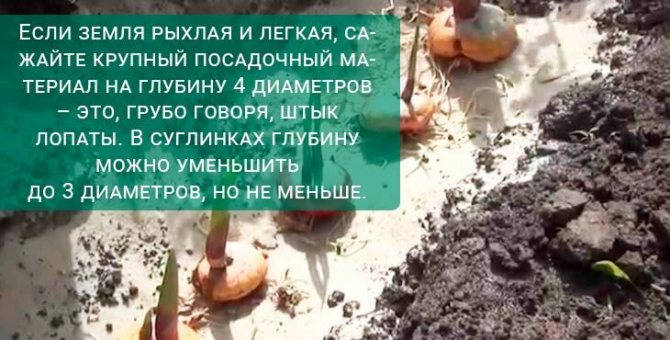

In the correct groove:
- Consider the quality of the soil. In very loose soil, bury the bulb approximately on the bayonet of a shovel, this is about 4 bulb sizes. On denser soil, for example, if planted in loam, 3 sizes are sufficient.
- Plant more densely, then the planting density itself will be protection from the wind. But not thicker than 15cm.
- And the most important thing is to choose an area where there are no winds or install a "screen" of buildings or other plants.
All this is very simple to implement. By the way, cascade planting is also suitable. I will talk about this in the very last part of the article.
Methods for combating diseases and pests of gladioli
| Disease | Manifestation on leaves and other symptoms | Elimination methods |
| Fusarium disease | Turn yellow, covered with a whitish bloom. | If the disease occurs during the growing season, the plant is unlikely to survive, so it should be removed along with the surrounding soil. To exclude the occurrence, treat the bulbs before planting with a manganese solution. |
| Sclerotinosis | Wither, dry up at the base, the stem rots. | Dig up the affected gladioli immediately to prevent spread. If the disease has just begun, treat the flower with a solution of fungicides: Ordan, Hom, Previkur. |
| Scab | Black markings on corms and all parts of the skewer. | Acidify soil and remove infested flowers. |
| Viral infection. | The stem may be covered with brown lines. Black dots protrude on the outside. | It is impossible to completely cure. Dispose of the infected plant to prevent spreading the infection. |
| Shield. | Sprouts die off. Are covered with spots. | Use Permethrin, Bi 58, Phosphamide, Methylmercaptophos or soap solution. |
| Aphid. | Green small insects on the surface, stem. Philodendron dies. | Lemon juice tincture, Intavir, Aktofit. |
| Spider mite. | A thin, dense white web envelops the stem and leaves. | Water regularly, apply Neoron, Omite, Fitoverm according to the instructions. |
| Thrips. | Thin white streaks appear. The plant wilts, withers. | Use Fitoverm, treat with Aktara, Mospilan, Aktellik or Calypso. |
When to plant gladioli seedlings in 2019
After germination, you can plant the bulbs on the seedlings. For this, it is worth considering when the soil in your area warms up to 8-10 degrees. And it could be. Both at the end of April and at the beginning of June. And accordingly, it is worth starting to plant gladioli. (It is very important to do everything on time so that the sprouts do not overgrow, then it will be more difficult for them to acclimatize in the soil).
In mid-March for warmer regions and until mid-April (in regions with colder climates), you can start planting skewers on seedlings. Provide additional lighting if necessary!
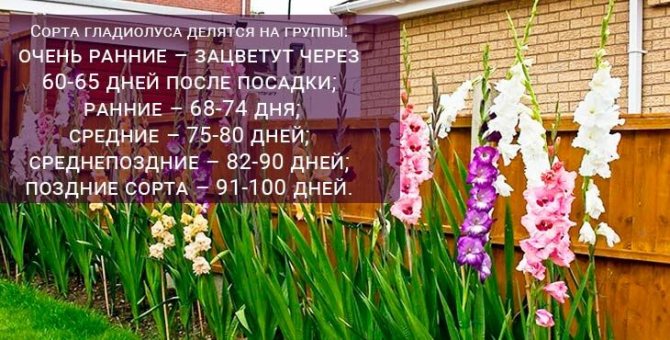

According to the lunar calendar 2020, the following days are considered favorable:
- April - 6-8, 20-26, 29, 30.
- May - 6-8, 14-17, 21-23, 31.
- June - 1, 2, 9-11.
These dates are relevant for planting, both in the open ground of planting material and for seedlings.
The best varieties
There are several varieties that are adapted to our climate.
Golden fantasy
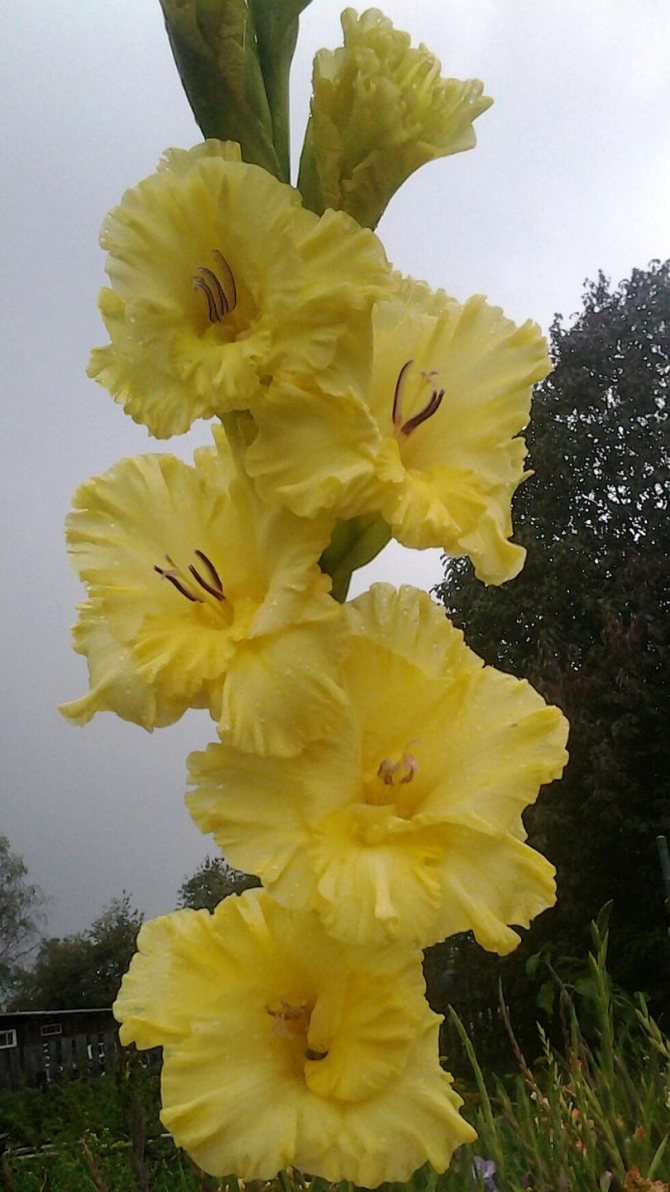

Cultivation of gladioli began in the 16th century.
An early flowering variety bred in Holland and adapted to our climate. The flowers are large, rounded, strongly corrugated. There are 23 buds in an ear, the flowers open almost simultaneously. The stem is powerful, up to 1.6 m high. It reproduces well.
Newday
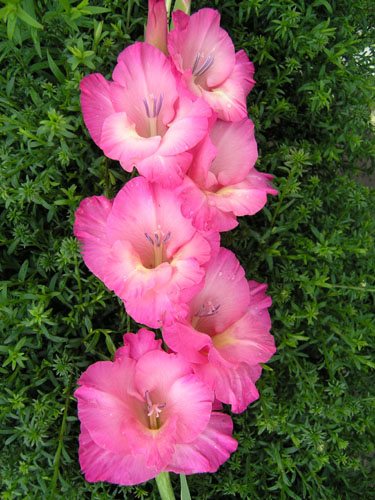

The first hybrids emerged from two crossed South African plant species
Medium flowering variety. The flowers are large. There are 18 buds in an ear, 6 flowers open each. The average height of the stem is 1.2–1.4 m. The color is crimson, the petals are corrugated.
Viy
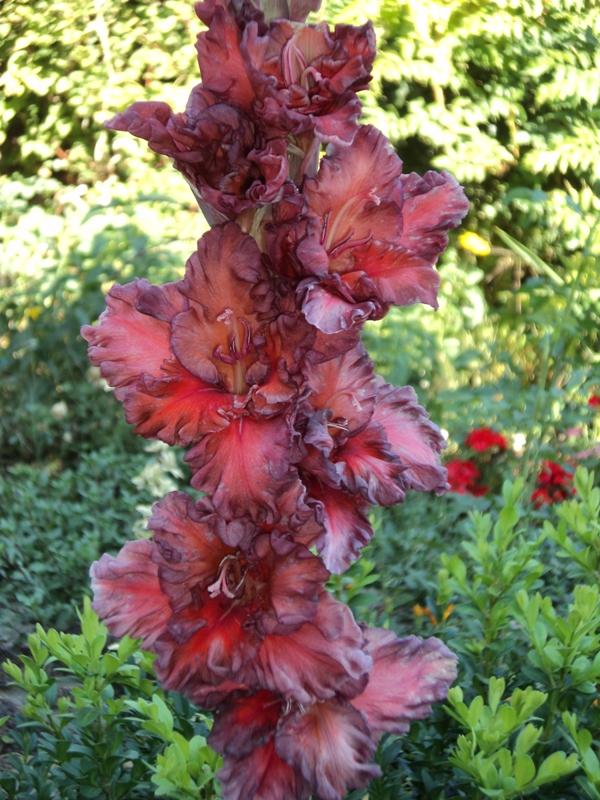

Gladiolus contains a large amount of vitamin C, so it is used as a prophylactic agent for colds.
The flowering period of the variety is average. The flowers are medium in size. There are 20 buds in an ear. Only 6 flowers open at a time. The color is from crimson smoky to purple smoky with a brown tint and significant corrugation on the petals. The stem reaches a height of 1.3 m.
Chocolate girl
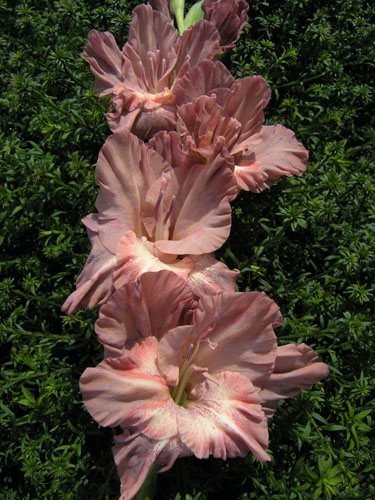

The Shokoladnitsa variety is characterized by good resistance to various diseases and high yield.
Medium flowering variety. The flowers are large. There are 21 buds in an ear, 7 flowers open at the same time. The color is light brown with a chocolate sheen and a white spot. The petals are strongly corrugated. The stem is tall and powerful, up to 1.5–1.6 m in height.
Esperanto
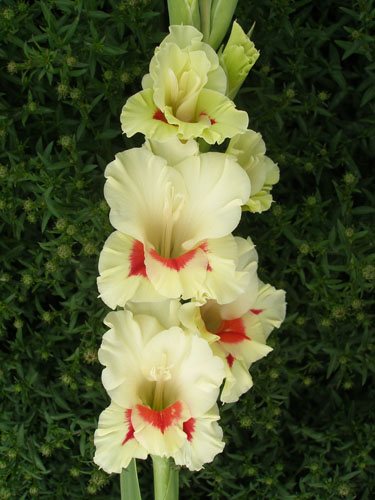

Gladiolus petals and leaves are used in home cosmetology to prepare face masks.
Medium flowering variety. The buds are medium in size, there are 21 pieces in an ear, 6 flowers open at the same time. The color is creamy with red spots. The petals are slightly corrugated. Stem height up to 1.3 m.
When to plant bulbs in open ground in spring
Keep in mind that early varieties bloom on day 68, later ones on day 100. This means that if you have additionally germinated your planting material, you can choose a time for your plants to bloom for a specific event. Of course, it is worth considering which variety you are planting: early, middle or late.
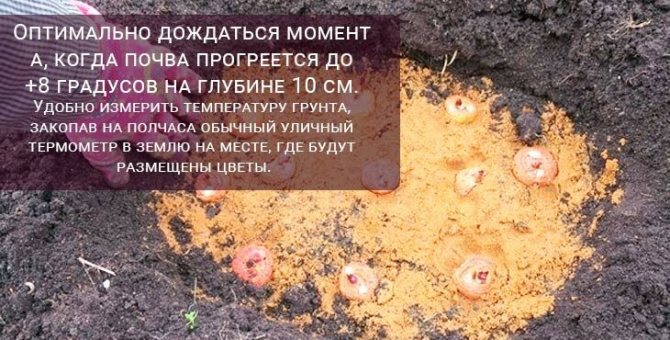

For example, by September 1, the plants that you planted in mid-May will bloom (in regions with a warm climate. In a colder one - in June). By the way, if the summer is short where you live, it is worth choosing early varieties of skewer!
Cleaning and storage of tubers
The tubers are harvested in autumn, around mid to late September, 30–40 days after flowering. Digging should be done in dry weather, when the soil is not waterlogged. First, the early varieties are dug, then the later ones. It is better to discard damaged tubers. If this is massive, then you can try to clear them of the "infection" and the next year be sure to change the landing site.
It is recommended to trim the stems before digging. The roots are also trimmed, and the tubers are thoroughly cleaned of the soil. If they are wet, then they are dried. Drying takes place in a container with a mesh bottom so that there is no lack of ventilation.The bulbs must be pre-rinsed with clean water.
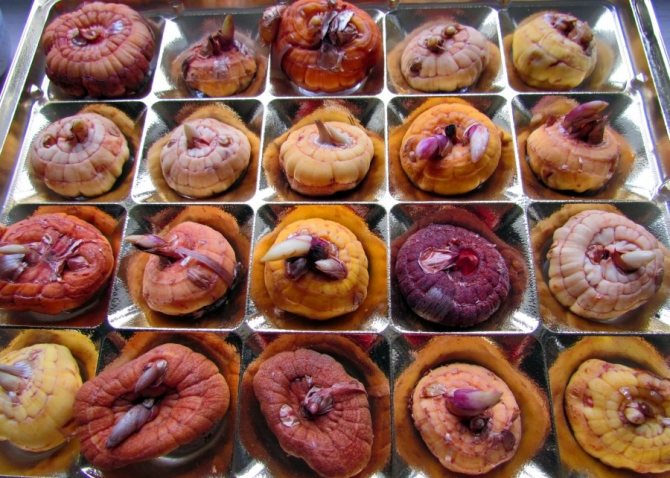

Gladiolus bulbs must be dried within 30 days
To prevent the development of possible diseases or the appearance of parasites, the tubers are treated with a weak solution of potassium permanganate or a solution of Fundazol. To do this, they are placed in a solution for 20-30 minutes and dried for 3 days at a temperature of about +25 ° C. Then the temperature is lowered to + 15-18 ° C.
A month later, the tubers are cleaned from the scales and separated from the mother bulbs of the "babies". After that, they are sorted by size and placed in paper bags. The optimum storage temperature should be between + 5–6 ° C. Temperatures below 0 ° C can destroy seedlings, while temperatures above +10 ° C can cause seedlings or the appearance of fungi and parasites. The optimum air humidity is 60–70%.
For storage, special cellars, refrigerators and basements are used. In warm regions, a balcony can be used. In this case, the tubers should be wrapped in a blanket or old clothing. This will maintain the temperature regime and avoid moisture accumulation.
Growing gladioli in pots outdoors
Surprisingly, gladioli thrive in pots, flowerpots and flowerpots. If this is your first time doing this, choose undersized varieties.
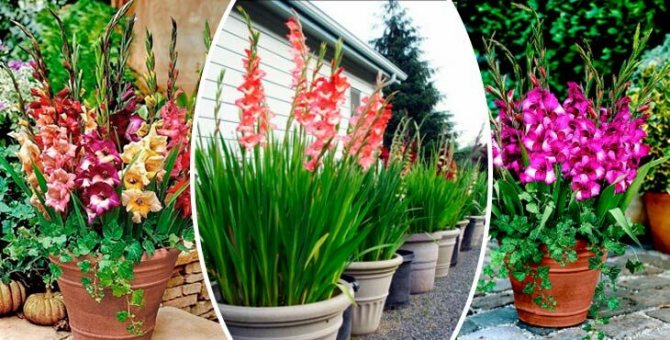

But you need to take into account the following requirements:
- The dimensions of the pot should be: diameter - 20-30cm, depth - 30-40cm.
- A high drainage layer should be laid at the bottom.
- The soil is very light, enriched with organic matter.
- Planting time is from late March to mid-May.


You need to find a place where there are no drafts and scorching sun. You may need a garter and be sure to loosen the soil in the flowerpots.
Why gladioli don't grow
Gladioli are whimsical plants and, in order to have a beautiful and abundantly blooming front garden, every summer you need to properly care for and follow some of the prescriptions:
- The skater must be grown in 2-3 years on a new site, since he does not like to be in one place for several years in a row (more than three).
- It is important for culture to change not only the territory, but also the composition of the soil. For example, if you immediately plant a plant on black soil, then in another period it is desirable to change it to sandy loam.
- It is better to purchase material adapted to climatic conditions for growing. So, Dutch specimens will most often bloom only in the first year, and in the future they will be sick.
- It is important to maintain the correct planting depth. Violation of this norm causes negative deviations in growth and development.
- Juvenile bulbs (babies) do not tolerate being close to large specimens that oppress them. It is best to separate small and large bulbs separately.
- 3-5 days before planting, the baby must be cleaned of hard scales, otherwise it may not germinate.
- Plants need to be watered and loosened in a timely manner, as well as top dressing.
- Weeds should be removed, which often oppress gladioli, interfering with their normal growth and development.
- Thrips, a small pest, causes great harm to the crop, so about three treatments with Fitoverm should be carried out from July to August.
- It will not work to grow large gladioli if a small onion is allowed to bloom in full force, so it is better to remove the peduncle from such an instance.
When and how to plant gladioli in the Moscow region
In the middle lane with its temperate climate, gladioli can be planted at the end of May, when the soil warms up to 10 degrees and there is no longer a threat of frost. It is necessary to deepen the bulbs by 5-8 cm, depending on the quality of the soil.
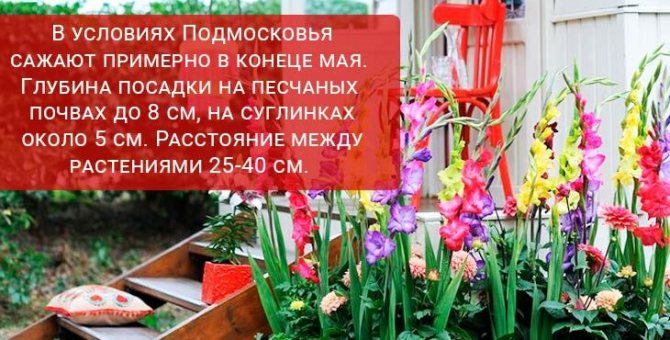

Loam predominates here. Therefore, do not deepen the landing too much. It is advisable to introduce organic matter into the soil in advance, even in the fall, and let it overheat during the winter. This will not only enrich the earth with useful substances, but also make it more suitable.
Flower care
Agricultural technology for growing gladioli in the open field includes the following elements of care - watering, mulching, feeding, tying, spraying against diseases and pests.
Watering and mulching
The first layer of gladiolus roots penetrates to a depth of 40–45 cm, providing the shoot with moisture and nutrition. From the moment the roots form on a young bulb, you need to make sure that the surface layer of the soil is moist. In June, it is enough to water the seedlings once a week at the rate of 2 buckets / m². The need for moisture increases during the period of budding, flowering, the establishment of hotter weather - at the same rate, the frequency of watering is increased to 2-3 times a week.
Water the plants under the root, being careful not to get on the leaves, with water heated in the sun during the day. Do not forget to loosen the soil after the top layer has dried.
Mulching will help to preserve moisture and soil structure - covering the root zone with a layer of peat, compost, grass at least 5 cm thick. Mulch, in addition to retaining moisture, feeds the plant with useful substances that are released as organic matter decomposes.
Top dressing
Gladioli are usually fed three times a season.
- At the germination stage (2–4 leaves), nitrogen fertilization is given. Of organic fertilizers, flowers respond well to a solution of dry chicken manure (1:15), horse manure (1: 7). But it is better not to offer mullein. Nitrogenous fertilizers take 25-30 g / m².
- The second feeding is needed complex, so that, in addition to nitrogen, there is potassium and phosphorus in the composition. Do it in the phase of 5-6 sheets. The dose is 50-60 g / m².
- The budding phase is the time for the third feeding. At this time, the plant needs phosphorus and potassium. You can use special complexes for flowering or superphosphate (30-40 g / m²) and potassium chloride (15-20 g / m²).
Spraying, garter
When growing gladioli in the open field, care must be taken to protect them from any misfortune. Sometimes it is enough to pickle the corms before planting. But if there is a whitefly on the site, she will not miss her. Any insecticide can be used against it.
Another common garden flower problem is thrips. If yellow spots, dry bald spots appear on the leaves, urgently spray the plants with insecticides with acarcidal effect (karbofos, metaphos, etc.)
Tall and unstable stems are tied up. To do this, use a strong coarse mesh - it is pulled over the seedlings before forcing the peduncles, as they grow, they are passed into the cells. The second option is individual pegs or special supports (as for orchids).
Gladiolus is a cut crop. As soon as the first flower has opened, the arrow can be sent to the vase, where it will dissolve every last bud. This is also useful for corms, as they have more time to accumulate nutrients and ripen.
Planting and caring for gladioli in the Urals
The most optimal time for planting a skewer in this region is the second half of May. In the Urals, summer is short. How to have time to grow a culture so that it not only gives a beautiful bush, but also blooms? It would be most correct to choose early varieties.


It is worth planting not only early varieties, but also lower ones, which do not need to take a lot of nutrients from the soil for normal development, health and flowering. It is worth making sure that the soil in the flowerbed with gladioli is not waterlogged. Perhaps, if there is a moisture retention, then you need to pre-seal the drainage into the ground in the flower bed or more often loosen and reduce watering (water only if necessary).
Care and cultivation of gladioli
Experienced growers give recommendations. The more precisely you adhere to the rules, the more chances for the emergence of strong peduncles and luxurious buds.
Watering
Gladioli grow in the sun and need to be supplemented regularly. The soil should not be dry, otherwise the buds are poorly tied, the flowers become smaller, the plant withers.Strong boggy is also not needed: Fusarium develops, gray rot.
The best option is to water the skewer abundantly every week (up to 12 liters of liquid per 1 sq. M). In extreme heat, watering is carried out every three to four days, preferably in the evening. When planting, it is useful to put sphagnum or river sand (a couple of centimeters) on the bottom of the grooves of moss to retain moisture in the root zone. Loosening is not very deep, but regular.
Weeding
Weeds often appear in the nutrient soil next to gladioli. Do not wait for the parasitic plants to "clog" the flowers and take most of the nutrients from the soil. Slugs actively settle in the weeds.
Weeding is carried out as needed (three to four times per summer). Be sure to pull out herbs with roots, and not only the aerial part of wheatgrass and other harmful plants.
Autumn and spring digging of the soil reduces the number of weeds on the site.
Garter
Gladioli are actively extended, the stems in some species reach 70–80 cm or more. Timely garter (when the first buds are ejected) prevents stem breakage, reduces the load on the lower part. The support is made of rods, between them a strong nylon cord or other material is stretched horizontally.
Fertilizers and feeding
There are two types of nutrient mixtures:
- Foliar dressing (spraying). It is carried out during the ejection of buds and flowering. One of the safe and useful components is natural succinic acid for plants. It is useful to spray a solution of boric acid, potassium permanganate or copper sulfate in a minimum concentration.
- Root dressing. The first time - when one or two leaves appear, the second procedure - when the fifth or sixth leaf is thrown out. The third time, fertilizers are applied shortly before budding at the skewer.
You can feed the soil with organic matter (not very strong, for example, diluted bird droppings), mineral fertilizers. Flower shops sell liquid fertilizers for gladioli. When the peduncles come out, it is useful to add Nitrophoska.
Shortly before planting gladioli, phosphorus and potash fertilizers are introduced into the soil, then the substrate is dug up. Before planting in spring, it is useful to nourish the soil with chlorine-free potash mixtures.
Beautifully flowering plants need additional feeding with microelements. Boron, copper, molybdenum, zinc sulfate have a positive effect on skewer,
A warning! It is strictly forbidden to fertilize the soil for gladioli with horse manure.
Reproduction
You can breed gladiolus in your summer cottage in different ways. Each method has pros and cons.
Breeding methods:
- corms (most popular);
- kidneys;
- seeds.
Cutting flowers
Flowers are suitable for cutting, which, after removing the top, have at least four leaves. Gladioli are cut in the evening or early in the morning, the peduncle is separated close to the axils of the leaves, obliquely, with a sharp knife. A luxurious flower is placed in water. 1 tablet of activated charcoal or 1 tsp helps to keep cut gladioli longer. boric acid in 1 medium vase of flowers.
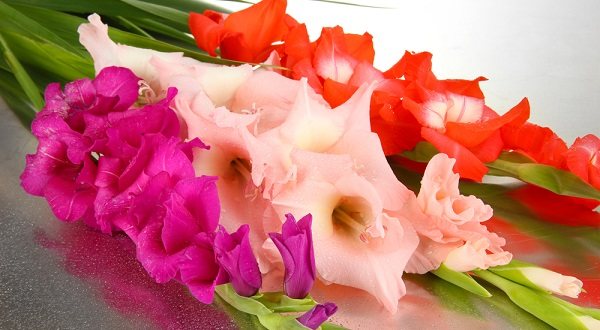

How to grow gladioli in Siberia
Siberia also differs in weather conditions. What to focus on when disembarking? The most correct is the soil temperature. In some regions, the ground (at a depth of 10 cm) warms up to the 8-10 degrees we need in early May. In others, at the end of May, beginning of June.


What other features of growing skewers in Siberia:
- Germination - will help to achieve uniform good flowering of gladioli in your area.
- Landings are made thicker. Distance between plants - 10-15cm, between rows - 25-30. This will help the culture to retain the necessary warmth and create its own microclimate that is comfortable for it.
- The bulbs are planted in dry sand. The sand layer is increased to 3 cm.
- After planting, the wells are filled with warm water.
- It is better to water the planted material not from above, so as not to compact the soil over the bulbs, but into the grooves made next to the planting.
- Leaving involves a garter to the pegs. It is very important!
- And spraying with fungicide solutions from pests.
Of course, in these regions neither watering nor loosening of the soil can be neglected!
When to dig up gladioli
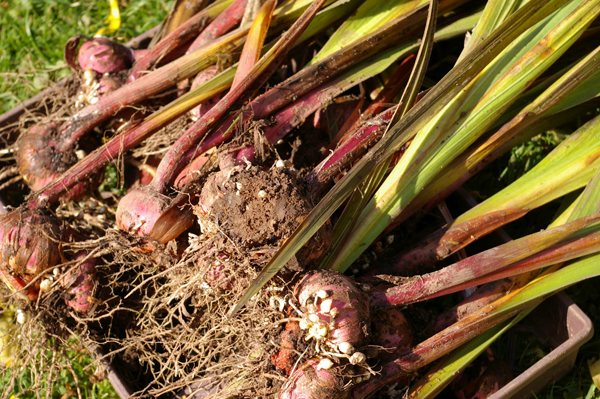

The bulbs must be fully ripe before they can be dug up. That is why they are not in a hurry with the procedure. You need to start it no earlier than September. In southern regions, digging up the bulbs can be postponed until October.
After cutting the peduncle, the plant is not disturbed for 30-45 days. During this time, gladioli will distill juices from the leaves into the underground part. A well-nourished bulb will winter better. It is necessary to carry out work in dry warm weather.
On a note! When digging up the bulbs, proceed carefully so as not to damage the children formed nearby.
Growing conditions and choice of planting site
To create the best conditions for plant growth, it is necessary to take into account that gladiolus does not like low-lying, with stagnant moisture, soils. Oversaturation with moisture contributes to rotting of the bulb. Slopes with hummocks will also be unacceptable. Only a flat, dry place, which will not only be well lit, but also protected from the wind, will be suitable for planting gladioli. But you can not also overdo it with this, since complete calm can contribute to the development of diseases of a fungal nature.
Semi-shady places are suitable for growing only early varieties of gladioli... If late flower varieties are planted in such a place, they will not bloom at all. And the reason will lie in the lack of lighting. It should also be borne in mind that this is a very thermophilic flower.
Before planting, remember what kind of crop was cultivated on this plot of land last season. If these were flowers from the genus of dahlias, marigolds or plants from the legume family, strawberries and tomatoes, then feel free to use this piece of land to grow gladioli. Be wary of the area where potatoes, carrots or cabbage grew last season, as well as all those plants that were fertilized with manure. But it is very important that every 2 years the gladiolus is transplanted to a new place.
Reproduction of gladioli
Gladioli reproduce vegetatively, that is, the mother corm gives replacement corms and many tubers or so-called babies. Every year, children must be planted to rejuvenate the bulbs, and replacement ones can be used up to five years. In this case, the baby should be planted much earlier than adult tubers. Before planting, the baby should be cleaned of scales, since it rises in an unpeeled form in 60 days, and in a cleaned one - in two weeks and soak in a solution with growth stimulants.
Growing seedlings from gladiolus babies
Preparing children for planting involves carrying out certain activities. The collected planting material is taken from the storage, cleaned of dry husks, if necessary, soaked for a day in warm water. This stimulates the rhizomes to start growing. After that, the children are planted in prepared soil, poured into a flower pot or box, and wait for their germination. Further, the planting is moistened and left for a week in a warm, well-lit room, waiting for the sprouts to appear.
See also
Description and characteristics of varieties and types of hyacinths, growing rulesRead


